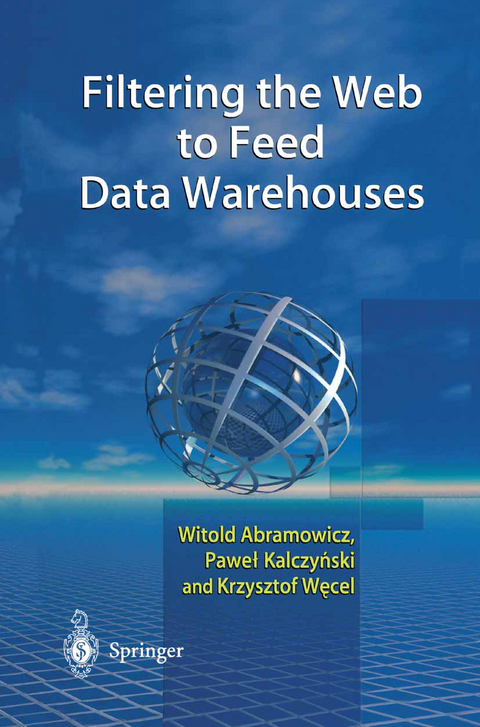
Filtering the Web to Feed Data Warehouses
Springer London Ltd (Verlag)
978-1-4471-1107-8 (ISBN)
- how to use data warehouse for filtering Web content
- how to retrieve relevant information from diverse sources on the Web
- how to handle the time aspect
- how to mechanically establish links among data warehouse structures and documents filtered from external sources
- how to use collected information to increase corporate knowledge
and gives a comprehensive example, illustrating the idea of supplying data warehouses with relevant information filtered from the Web.
1 Introduction.- 1.1 Information Systems.- 1.2 Information Filtering Systems.- 1.3 Database Systems.- 1.4 Organization of this Book.- 2 Data Warehouse: Corporate Knowledge Repository.- 2.1 Introduction.- 2.2 Data Warehouse Definition and Features.- 2.3 Data Warehouse System.- 2.4 Deploying Data Warehouse in the Organization.- 2.5 Knowledge Management in Data Warehouses.- 2.6 Evolution of the Data Warehouse.- 2.7 Chapter Summary.- 2.8 References.- 3 Knowledge Representation Standards.- 3.1 Introduction.- 3.2 Markup Languages.- 3.3 Dublin Core.- 3.4 Warwick Framework.- 3.5 Meta Content Framework.- 3.6 Resource Description Framework.- 3.7 Common Warehouse Metamodel.- 3.8 Chapter Summary.- 3.9 References.- 4 Information Filtering And Retrieval From Web Sources.- 4.1 Introduction.- 4.2 Information Retrieval Systems.- 4.3 Information Filtering Systems.- 4.4 Internet Sources of Business Information.- 4.5 Filtering the Web to Feed Business Information Systems.- 4.6 Chapter Summary.- 4.7 References.- 5 Enhanced Data Warehouse.- 5.1 Introduction.- 5.2 Justification of the Need for Integration.- 5.3 Preliminary Vision of the System.- 5.4 Software Agents.- 5.5 Proposed Solution: enhanced Data Warehouse.- 5.6 Formal Model of eDW.- 5.7 System Implementation.- 5.8 Chapter Summary.- 5.9 References.- 6 Profiling.- 6.1 Introduction.- 6.2 Personalization and Data Warehouse Profiles.- 6.3 Algorithms Specification.- 6.4 Profiling Server.- 6.5 Chapter Summary.- 6.6 References.- 7 Source Exploitation.- 7.1 Introduction.- 7.2 Sample Business Content Providers.- 7.3 Information Ants to Filter Information from Internet Sources.- 7.4 Indexing Parser.- 7.5 Transparent Filtering in the eDW System.- 7.6 Chapter Summary.- 7.7 References.- 8 Building Data Warehouse Library.- 8.1 Introduction.- 8.2 Time Indexing.- 8.3 Experiment with Time Indexing.- 8.4 Future Trends: Multimedia Indexing.- 8.5 Chapter Summary.- 8.6 References.- 9 Context Queries And Enhanced Reports.- 9.1 Introduction.- 9.2 Context Queries.- 9.3 enhanced Report.- 9.4 Reporting Application.- 9.5 Histograms: The Helpful Tool for Analysis.- 9.6 Chapter Summary.- 9.7 References.- 10 Conclusions.- 10.1 Concluding Remarks.- 10.2 Improvements.- 10.3 Open Issues and Future Work.
| Zusatzinfo | XII, 267 p. |
|---|---|
| Verlagsort | England |
| Sprache | englisch |
| Maße | 155 x 235 mm |
| Themenwelt | Sachbuch/Ratgeber ► Natur / Technik ► Naturwissenschaft |
| Informatik ► Datenbanken ► Data Warehouse / Data Mining | |
| Informatik ► Theorie / Studium ► Algorithmen | |
| Mathematik / Informatik ► Informatik ► Web / Internet | |
| Wirtschaft ► Betriebswirtschaft / Management | |
| Schlagworte | Database Models • Data Warehousing • Information Filtering • WWW |
| ISBN-10 | 1-4471-1107-9 / 1447111079 |
| ISBN-13 | 978-1-4471-1107-8 / 9781447111078 |
| Zustand | Neuware |
| Haben Sie eine Frage zum Produkt? |
aus dem Bereich


